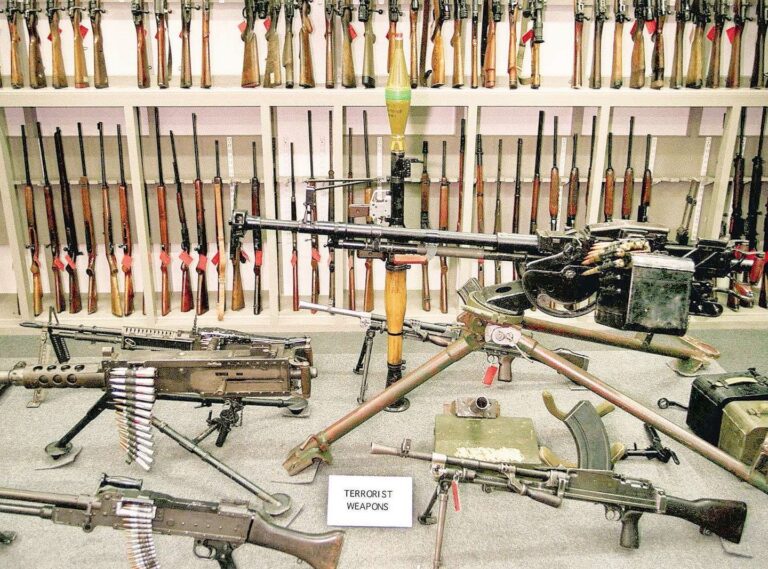Disarming Violence: Decommissioning and the Northern Irish Peace Process
Disposing of Weapons

The process of decommissioning weapons formalized by the Good Friday Agreement gave considerable leeway and latitude towards the paramilitaries themselves, especially compared to other disarmament schemes. The agreement itself was fairly vague about specifics on the decommissioning process, only instructing participants to “reaffirm their commitment to the total disarmament of all paramilitary organizations” and “in good faith with the Independent Commission” to achieve the goal within two years.[1] In 1997, the U.K. and Irish governments established the Independent International Commission on Decommissioning (IICD) to act as the facilitator of disarmament, and the commission was led by Canadian General John de Chastelain. The Secretary of State for Northern Ireland, Mo Mowlam’s office, developed a scheme for decommissioning that gave paramilitaries options for how they could dispose of their guns and explosives. Any person or group who wished to decommission weapons had to establish contact with the IICD, who would send inspectors to assess the material. An amnesty period was established from July 1998 to February 2003, and the scheme provided guidelines for disposal by the commission itself or the entity in possession of illegal weapons. Inspectors would information on type, make, and number of guns, ammunition, and explosives would be recorded. The individuals or representatives of the groups decommissioning could also send representatives to observe the proceedings. The specifics of how weapons would be destroyed are left open, and could include “cutting, bending, chipping, stamping and grinding and the disposal of the residue” of guns or controlled demolition of explosives. Notably, the data gathered on weapons was to be kept confidential, so paramilitary volunteers could not be prosecuted for crimes linked to specific weapons.[2] With several options for how to dispose of weapons, and with the promise of amnesty and confidentiality, the scheme was fairly generous to paramilitaries.
Despite this, many paramilitary groups were slow to start decommissioning. By 2000, only the Loyalist Volunteer Force, a small unionist group, had actually decommissioned any of its weapons.[3] While the IRA and larger unionist groups were in contact with the IICD, the IRA publicly declared they would not decommission, calling it an “obstacle to progress” and expressing skepticism of the implementation of the Good Friday Agreement.[4] According to Andrew Sens, one of the leading officials at the IICD, the issue now became whether decommission would happen before or after the devolution of the Northern Irish government and new assembly: “’No guns, no government’ argued unionist politicians; ‘No government, no guns’ insisted the republicans.”[5]
As the Agreement went into effect, the IRA started to warm up to decommissioning, announcing on May 6, 2000 that they would “completely and verifiably put IRA arms beyond use” and allowing IICD inspectors to survey weapons caches later in June.[6] Other events, such as the bomb attack in Omagh by the dissident Real IRA in August 1998 and the arrest of three Irish republicans try to smuggle guns from Columbian guerrillas, further prompted the Provisionals to make steps towards decommissioning.[7] On October 23, 2001, the IICD reported that the first IRA weapons had been decommissioned.[8] The fourth and final act of decommissioning was announced on September 26, 2005.[9] Loyalist paramilitaries began decommissioning soon after, and the IICD released its final report on July 4, 2011.[10]
The decommissioning of weapons in Northern Ireland provides a notable contrast to other disarmament schemes during times of civil war or unrest in which more authoritarian measures are used to protect the state’s monopoly of violence.[11] By having paramilitaries hand over weapons to an independent body, rather than the British government, it avoided the perception that disarming equated to defeat or surrender. Furthermore, despite issues early on, the gradual success of decommissioning shows the value in patience and flexibility when implementing peace plans.
[1] “The Agreement: Agreement reached in the multi-party negotiations (10 April 1998),” CAIN Archive, CAIN Web Service, Accessed 4 April, 2022. https://cain.ulster.ac.uk/events/peace/docs/agreement.htm#decomm.
[2] Adam Ingram, “Decommissioning Scheme based on Section 3(1)(c) and (d) of the Northern Ireland Arms Decommissioning Act 1997” CAIN Archive, CAIN Web Service, Accessed 4 April 2022. https://cain.ulster.ac.uk/events/peace/decommission/nio290698.pdf.
[3] “Report of the Independent International Commission on Decommissioning (IICD), 2 July 1999,” CAIN Archive, CAIN Web Service, Accessed 4 April 2022. https://cain.ulster.ac.uk/events/peace/decommission/iicd020799.htm.
[4] “Irish Republican Army (IRA) Statement on Decommissioning, (30 April 1998),” CAIN Archive, CAIN Web Service, Accessed 4 April 2022. https://cain.ulster.ac.uk/events/peace/docs/ira30498.htm.
[5] Andrew Sens. “A Commission to Decommission Paramilitary Arms: Northern Ireland’s Example.” World Policy Journal, Vol. 23 No. 4 (2006), 75-85. 79.
[6] “Statement by the Irish Republican Army (IRA), issued (at midday) Saturday 6 May 2000,” CAIN Archive, CAIN Web Service, Accessed 4 April 2022. https://cain.ulster.ac.uk/events/peace/docs/ira060500.htm.
[7] English, Armed Struggle, 331.
[8] Statement by the Independent International Commission on Decommissioning (IICD), 23 October 2001,” CAIN Archive, CAIN Web Service, Accessed 4 April 2022. https://cain.ulster.ac.uk/events/peace/decommission/iicd231001.htm.
[9] “Report of the Independent International Commission on Decommissioning,” CAIN Archive, CAIN Web Service, Accessed 4 April 2022. https://cain.ulster.ac.uk/events/peace/decommission/iicd260905.pdf.
[10] “Final Report of the Independent International Commission on Decommissioning,” CAIN Archive, CAIN Web Service, Accessed 4 April 2022. https://cain.ulster.ac.uk/events/peace/decommission/iicd040711.pdf.
[11] Yuri M. Zhukov, “Taking Away the Guns: Forcible Disarmament and Rebellion,” Journal of Peace Research
53: 2 (March 2016), 242-258.